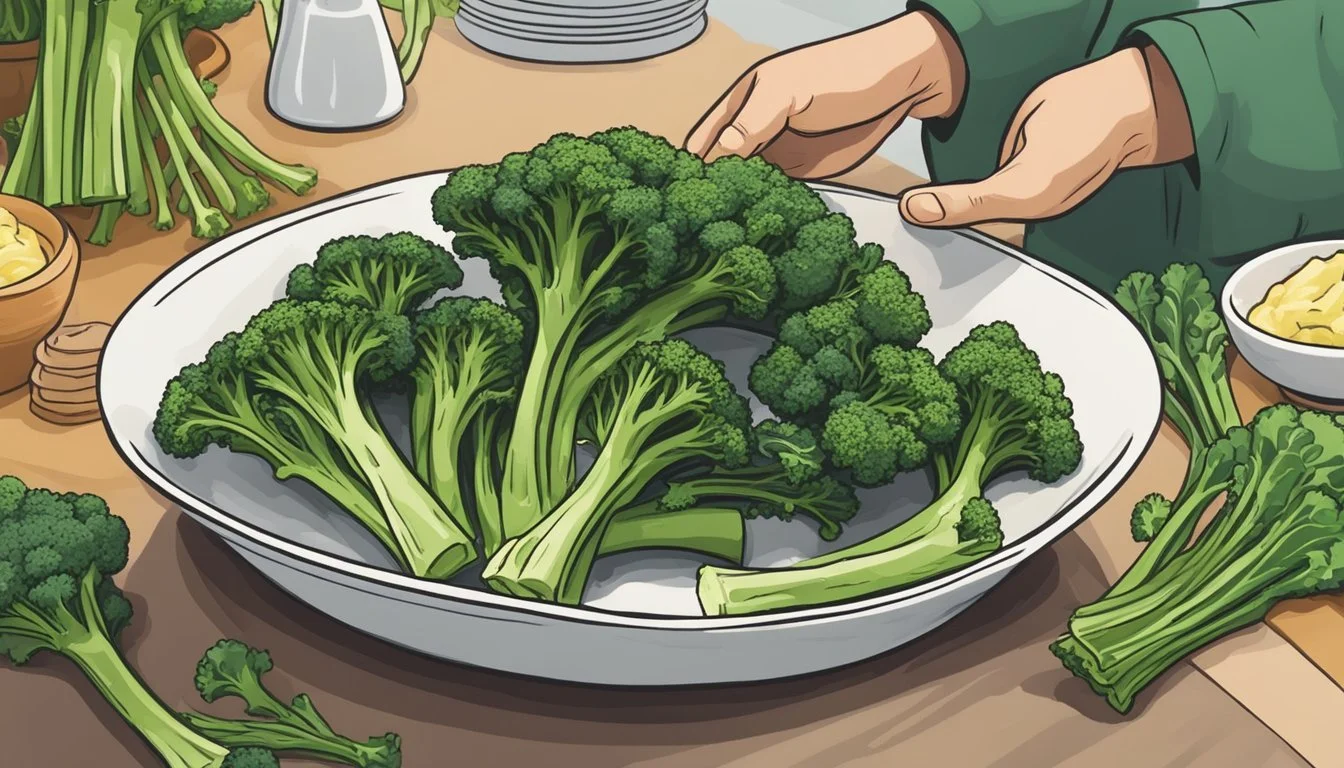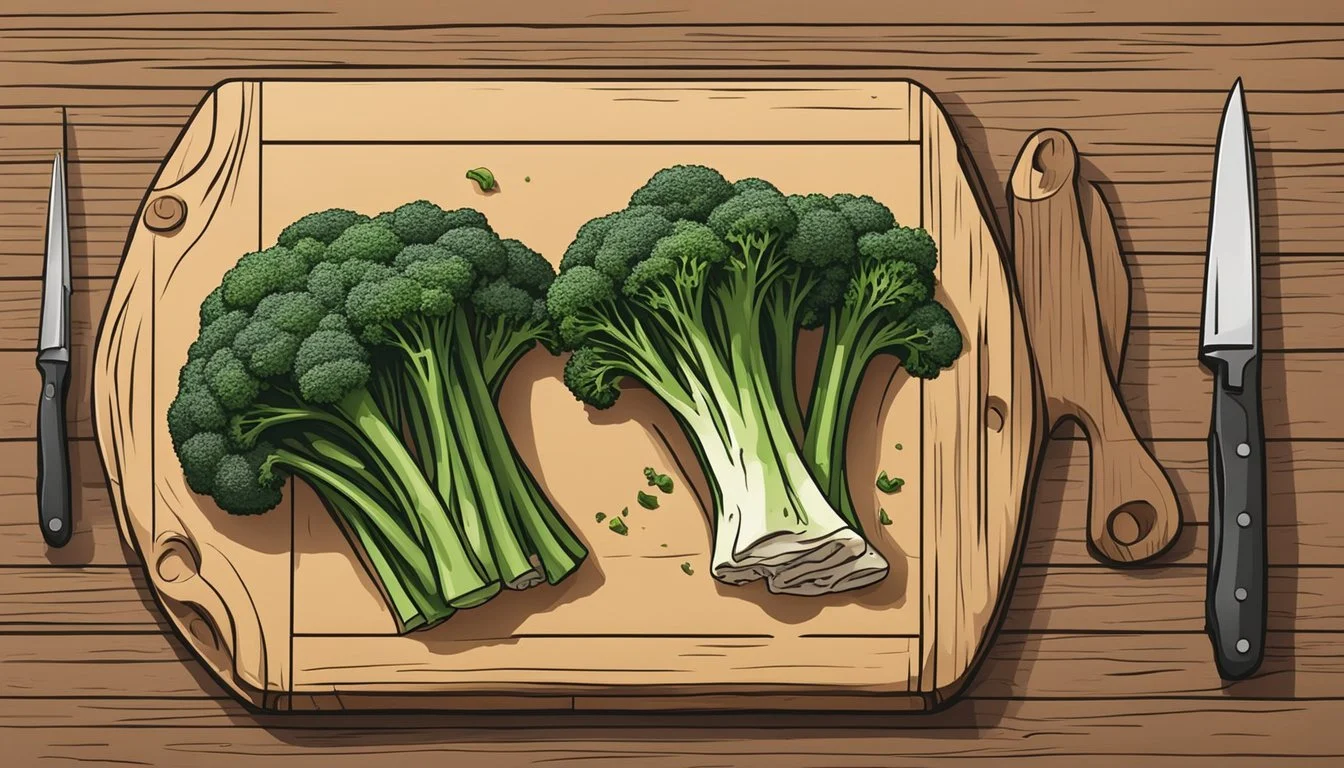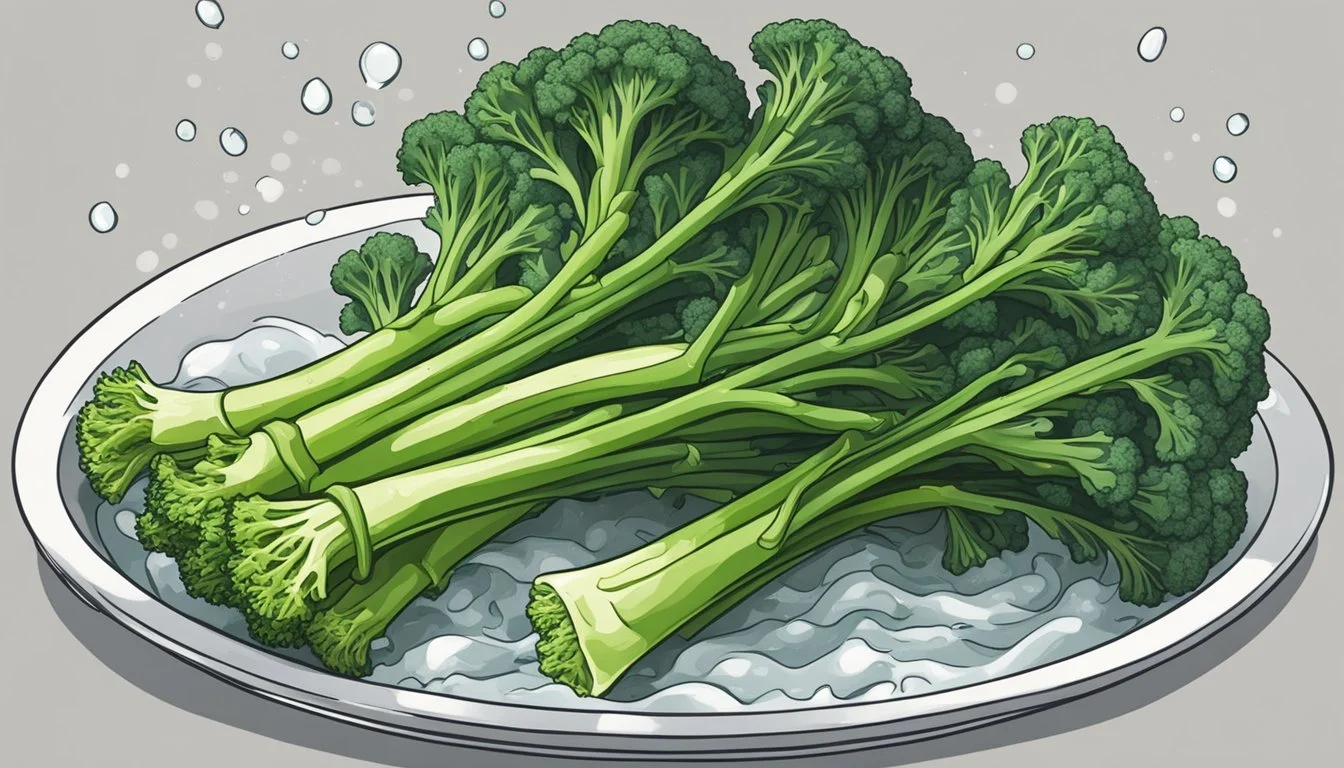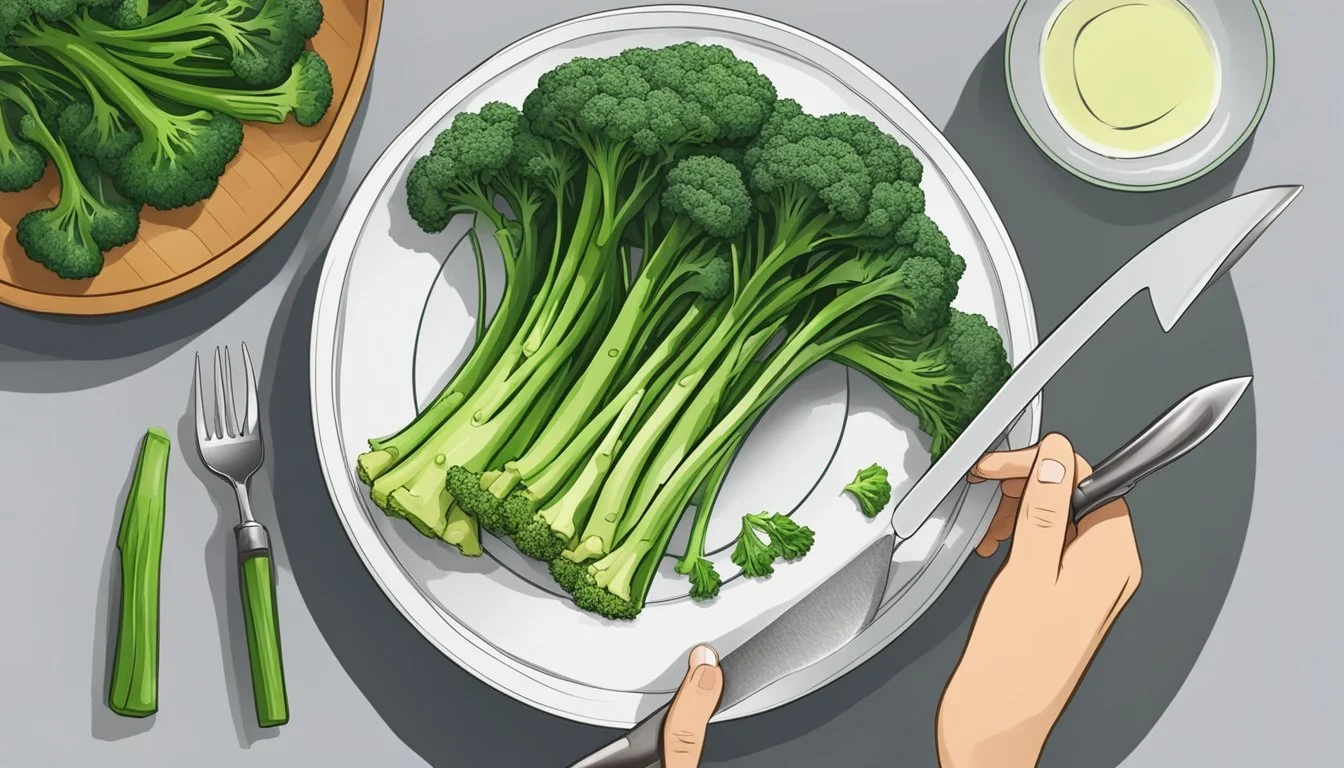How to Substitute Broccolini for Broccoli
Easy Swap Guide
Substituting broccolini for broccoli in recipes is a common practice for those looking to explore different textures and flavors in their dishes. Broccolini, often recognized for its long stalks and small florets, is a hybrid of traditional broccoli and Chinese kale, known as kai-lan. It presents a sweeter and milder taste compared to its cousin, broccoli, making it a sought-after ingredient for those who prefer a less pronounced bitterness in their vegetables.
Both vegetables are nutritionally rich and share similarities in their appearance and cooking methods, which allows for a seamless substitution. Broccoli's slightly bitter flavor and firm texture can stand in place of broccolini in most recipes. When using broccoli as a substitute for broccolini, one must consider the difference in stem thickness, which can affect the cooking time.
Chefs and home cooks often make this swap due to broccoli's wide availability and the likelihood of it being a staple in many kitchens. It's important to make adjustments in preparation; for instance, broccoli stems may require peeling to match the more tender stems of broccolini. This exchange not only benefits those with accessibility issues but can also appeal to varied taste preferences and meet different dietary requirements.
Understanding Broccoli and Broccolini
In discerning the best ways to substitute broccolini with broccoli, it is essential to grasp the unique attributes of each vegetable. This includes their physical characteristics, taste profiles, and culinary uses.
Characteristics of Broccoli
Broccoli, a member of the cruciferous vegetable family, is known scientifically as Brassica oleracea var. italica. It is categorized by its large, green flower heads and thick, edible stems. Often referred to as calabrese, derived from the Italian region of Calabria where it first grew, broccoli has a firm texture and a slightly bitter flavor.
Characteristics of Broccolini
Broccolini, sometimes called baby broccoli, tender-stem broccoli, or asparations, is a hybrid vegetable created from a cross between broccoli and Chinese broccoli, or gai lan. It is recognized by its long, slender stems and small, flowery tops. Broccolini has a milder and sweeter taste and is noted for its tenderness.
The Difference Between Broccoli and Broccolini
The primary differences between broccoli and broccolini lie in their appearance and flavor profiles.
Appearance: Broccoli has a bushier head with a short, chunky stem. In contrast, broccolini features elongated stems with smaller floret heads.
Flavor: Broccoli presents a more pronounced, slightly bitter taste, while broccolini has a gentler, sweeter flavor, often seen as a bridge between its two parent vegetables.
Understanding these differences is crucial for anyone looking to substitute broccoli for broccolini in a recipe, ensuring that the dish retains similar textural and flavor qualities.
Nutritional Comparison
When considering a substitution between broccolini and broccoli, their nutritional profiles show some differences. Both are healthy vegetable options that provide essential nutrients, but they vary in their specific vitamin, mineral, fiber, and protein content.
Vitamin and Mineral Content
Broccolini and broccoli are both rich in vitamins and minerals, contributing favorably to a balanced diet. Here's a look at how they compare:
Vitamin C: Broccoli is an excellent source of vitamin C, which is important for the immune system and skin health.
Vitamin K: Both vegetables provide substantial amounts of vitamin K, essential for blood clotting and bone health.
Calcium: Broccoli has a higher calcium content, which is crucial for bone health and strength.
Iron: They both contain iron, which is necessary for blood production and oxygen transport.
Antioxidants: Broccoli typically contains higher levels of antioxidants, which help neutralize harmful free radicals in the body.
Caloric and Fat Content
Both broccolini and broccoli are low in calories and fat, making them ideal for weight management and general health. They compare as follows:
Calories: Broccoli and broccolini are both low-calorie vegetables, with broccoli being slightly lower in calories.
Fat: These vegetables are naturally low in fat, contributing minimally to daily fat intake.
Dietary Fiber and Protein
The fiber and protein content of these vegetables play a role in satiety and digestive health.
Fiber: Broccoli and broccolini are good sources of dietary fiber, important for digestive health. Broccoli, however, usually has a slightly higher fiber content.
Protein: They are relatively high in protein compared to other vegetables, with broccoli providing a bit more protein per serving.
By understanding these nutritional differences, consumers can make informed decisions when substituting broccolini for broccoli in their meals.
Preparing Broccolini as a Substitute
When substituting broccolini for broccoli, individuals must consider the flavor and texture differences to adjust cooking methods accordingly for optimal results.
Texture and Taste Considerations
Broccolini flaunts a more subtle and less bitter taste than broccoli, with a slight earthy flavor that is appealing in many dishes. Its crisp texture is retained best when it is not overcooked, allowing it to maintain a satisfying crunch.
Cooking Adjustments for Substitution
To successfully substitute broccolini for broccoli, chefs should note that broccolini stems are generally thinner and more tender. Here are common preparation methods:
Roasted: Broccolini may require less time to roast compared to broccoli; watch for the florets to turn lightly brown and crisp at the edges.
Steamed: Steam for a shorter duration than broccoli. Begin checking for doneness after 3-4 minutes.
Sauteed: Sauté the broccolini over medium heat for approximately 5 minutes, until the stalks are brightly colored but still firm.
Serving Suggestions
Broccolini can serve as an elegant side dish or be incorporated into main courses. Its milder flavor pairs well with both light and hearty flavors, making it versatile for multiple cuisines.ült It can complement proteins such as chicken or fish or be seasoned with garlic and lemon for a vibrant standalone side.
Incorporating Broccolini in Recipes
Broccolini, with its tender stalks and mild, peppery flavor, easily adapts to a variety of dishes where broccoli might traditionally be used. This versatility allows cooks to introduce a subtle, yet distinctive twist to familiar recipes.
Replacing Broccoli in Salads
When making salads, thinly slice broccolini to include both florets and stalks for a crunchier texture. Broccolini pairs well with strong flavors like feta cheese, nuts, or a tangy vinaigrette. To ensure the perfect tenderness, blanch the broccolini before adding it to salads, which also preserves its vibrant green color.
Using Broccolini in Soups and Stir-Fries
For soups and stir-fries, broccolini serves as an excellent substitute for broccoli. It should be added later in the cooking process to maintain its structure and bright color. In stir-fries, sauté broccolini for a few minutes to highlight its crispness. In soups, they should be simmered just until they become tender to ensure they contribute a textural contrast.
Creating Side Dishes with Broccolini
Broccolini can be transformed into a delightful side dish on its own. To infuse more flavor, one can roast it briefly with olive oil, garlic, and a sprinkle of salt, or steam it and dress it with a squeeze of lemon juice and a dash of pepper. Whether alongside a robust protein or as a complement to a nuanced grain dish, broccolini adds both nutrition and elegance.
Other Suitable Substitutions for Broccoli
In the quest to find alternatives to broccoli, a variety of vegetables can serve as suitable substitutes, each offering their own unique flavors and textures to a dish. These can range from leafy greens to firmer, crunchier options.
When to Choose Spinach or Kale
Spinach or kale can be excellent alternatives when one is looking for a softer texture and a different nutritional profile. Spinach, with its tender leaves, can be a subtle yet nutritious addition to dishes where the texture of broccoli is not the main concern. Both regular spinach leaves and baby spinach leaves are appropriate; the baby spinach leaves are particularly suited for raw applications, such as salads or sandwiches, due to their milder flavor.
In contrast, kale offers a more robust texture, along with a slightly bitter taste. Kale can withstand longer cooking times, making it suitable for sautés and soups where broccoli might be used. It’s essential to remove the tough stems and chop the leaves before use to replicate the consistency of broccoli.
Alternatives like Cauliflower and Green Beans
Cauliflower stands as a prime substitute for broccoli with its similar structure, including a central stalk and surrounding florets. Its mild taste and versatility make it a go-to alternative for a variety of broccoli dishes. One should note that cauliflower has a softer texture when cooked and should be monitored closely to avoid overcooking.
Green beans offer another option with their crisp texture and ease of preparation. They can be used in stir-fries, salads, or as a side dish, providing a crunchy bite which can mimic the texture of lightly cooked broccoli. Green beans should be trimmed and cooked just until tender to enhance their natural flavor and maintain their snap.
Using Leafy Greens as Substitutes
In addition to spinach and kale, a wide array of leafy green vegetables can take the place of broccoli in many recipes. Some of these include:
Collard greens: These are best used in cooked dishes and have a taste similar to kale.
Mustard greens: With a peppery flavor, they add a lively punch to meals.
Swiss chard: Its soft leaves and slightly bitter taste can complement a variety of dishes.
Turnip greens: They can be slightly spicier and are often used in Southern cuisine.
Each of these greens may require different preparation methods, such as removing tough stems or reducing cooking times, to best emulate the qualities of broccoli. When using these greens as substitutes, one should consider how their distinct flavors and textures will interact with other components of a dish.
Shopping for Broccolini and Broccoli
When seeking out broccolini or broccoli, one should be aware of the varying types available, how to discern freshness and quality, and the appropriate methods for their storage and preservation to maintain their nutritious value whether bought fresh or frozen.
Where to Buy Fresh and Frozen Varieties
Broccolini and broccoli can be typically sourced from supermarkets, local farmers' markets, and specialty produce stores.
Fresh: Typically found in the produce aisle
Frozen: Usually located in the frozen vegetables section
Selecting the Best Quality
To ensure one purchases high-quality broccolini or broccoli, here are specific things to look for:
Color: Rich green hues; broccolini should have darker green florets.
Stems: Firm to the touch; avoid those with woody or split ends.
Florets: Tightly closed, not flowering or yellowing.
Storage and Preservation Tips
Proper storage extends the shelf life of both broccolini and broccoli, whether they are fresh or frozen.
Fresh:
Refrigerate in a loose plastic bag with air holes.
Consume within 3-5 days for best quality.
Frozen:
Keep in the original packaging or an airtight container.
Use within 8 months for optimal flavor and texture.
Note: Both vegetables can be blanched and frozen for long-term storage. They can be prepared either raw or cooked but different storage methods may slightly alter texture or taste.
Closing Thoughts on Vegetable Substitution
When seeking substitutes for broccolini, one's kitchen can become a place of culinary adaptability. *Regular broccoli stands out as the closest relative and the most straightforward substitute. Its availability in the US and worldwide makes it an accessible option with comparable taste and texture.
For those desiring variation, asparagus delivers a slightly nutty flavor that can complement many dishes similarly to broccolini. Meanwhile, bok choy, often used in East Asian cuisine, offers a texture akin to Chinese kale and a delicate taste that can serve as a substitution in a pinch.
Brussels sprouts, another versatile vegetable, add unique dimensions to recipes, even if their shape differs. They maintain the desired green vibrancy and can fulfill nutritional roles akin to broccolini. When substituting, one must consider the character of each vegetable; while they may share qualities, their individuality in taste and texture should be celebrated.
It's crucial that substitutions are made thoughtfully, respecting the unique qualities of each vegetable:
Texture: Regular broccoli is the closest match
Flavor: Asparagus offers a compatible, yet distinct taste
Adaptability: Bok choy and Brussels sprouts can be used, keeping in mind their unique properties
Substitution is not just about replicating flavors but understanding the balance and harmony within the dish. Whether it’s the tender florets of regular broccoli or the leafy freshness of bok choy, each brings something special to the table. Cooking is about making do with what is at hand, and in the case of broccolini substitutes, the options are both plentiful and delightful.








